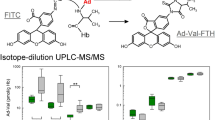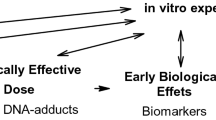Abstract
Covalent binding of benzidine and some congeners to hemoglobin was studied in female Wistar rats after oral administration. Hemoglobin adducts were hydrolyzed under alkaline conditions, and the arylamines extracted and analysed by HPLC with electrochemical detector. With benzidine, three cleavage products were observed, the major component being monoacetylbenzidine. This indicates that 4-nitroso-4′-N-acetylaminobiphenyl is the major reactive metabolite in erythrocytes. In addition benzidine and 4-aminobiphenyl were identified. The latter indicates a hitherto unknown metabolic pathway of benzidine. With 3,3′-dichlorobenzidine-dihydrochloride, 3,3′-dimethoxybenzidine and 3,3′-dimethylbenzidine two cleavage products were observed, the parent diamines being present in excess to or in amounts comparable to the monoacetyl derivative. With 3,3′,5,5′-tetramethylbenzidine a hemoglobin adduct could not be found. When the azo dye direct red 28 was administered to the animals, the three cleavage products typical for benzidine were found, indicating that benzidine became bioavailable after reductive cleavage of the azo compound. In this case the fraction of 4-aminobiphenyl was greater than after benzidine. It is proposed to use the analysis of hemoglobin adducts in human blood to control the exposure of individuals to these carcinogenic chemicals in the course of biochemical effect monitoring.
Similar content being viewed by others
References
Albrecht W (1985) Untersuchungen zur Hämoglobinbindung aromatischer Amino- und Nitroverbindungen bei Ratten. Ein Beitrag zum BiomonitoringN-substituierter Arylverbindungen. Dissertation der Julius-Maximilians-Universität Würzburg
Albrecht W, Neumann H-G (1985) Biomonitoring of aniline and nitrobenzene. Hemoglobin binding in rats and analysis of adducts. Arch Toxicol 57: 1–5
Birner G (1989) Zur Hämoglobinbindung aromatischer Amine und ihre Bedeutung für Expositionskontrolle und Risikobeurteilung im Rahmen des Biologischen Monitoring. Dissertation der Julius-Maximilians-Universität Würzburg
Birner G, Neumann H-G (1988) Biomonitoring of aromatic amines II: Hemoglobin binding of some monocyclic aromatic amines. Arch Toxicol 62: 110–115
Bos RP, Groenen MAM, Theuws JLG, Leijdekkers C-M, Henderson PT (1984) Metabolism of benzidine-based dyes and the appearance of mutagenic metabolites in urine of rats after oral, or intraperitoneal administration. Toxicology 31: 271–282
Bryant MS, Skipper PL, Tannenbaum SR, Mclure M (1987) Hemoglobin adducts of 4-aminobiphenyl in smokers and nonsmokers. Cancer Res 47: 602–608
Dölle B, Töpner W, Neumann H-G (1980) Reaction of arylnitroso compounds with mercaptans. Xenobiotica 10: 527–536
Eyer P (1979) Reactions of nitrosobenzene with reduced glutathione. Chem Biol Interact 24: 227–239
Frederick CB, Weis CC, Flammang TJ, Martin CN, Kadlubar FF (1985) HepaticN-oxidation, acetyltransfer and DNA-binding of the acetylated metabolites of the carcinogen benzidine. Carcinogenesis 6: 959–965
Genin WA (1977) Formation of blastomogenic diphenylamino derivatives as a result of the metabolism of direct azo dyes. Vopr Onkol 23: 50–52
Green LC, Skipper PL, Turesky RJ, Bryant MS, Tannenbaum SR (1984) In vivo dosimetry of 4-aminobiphenyl in rats via a cysteine adduct in hemoglobin. Cancer Res 44: 4254–4259
Holland VR, Saunders BC, Rose FL, Walpole AL (1974) A safer substitute for benzidine in the detection of blood. Tetrahedron 30: 3299–3302
Josephy PD, Eling T, Mason RP (1982) The horseradish peroxidase-catalyzed oxidation of 3,5,3′,5′-tetramethylbenzidine. J Biol Chem 257: 3669–3675
Kennelly JC, Beland FA, Kadlubar FF, Martin CN (1984) Binding ofN-acetylbenzidine andN,N′-diacetylbenzidine to hepatic DNA of rat and hamster in vivo and in vitro. Carcinogenesis 5: 407–412
Lowry LK, Tolos WP, Boeniger MF, Nony CR, Bowman MC (1980) Chemical monitoring of urine from workers potentially exposed to benzidine-derived azo dyes. Toxicol Lett 7: 29–36
Lynn RK, Donielson DW, Ilias AM, Kennish JM, Wong K, Matthews HB (1980) Metabolism of bisazobiphenyl dyes derived from benzidine, 3,3′-dimethylbenzidine or 3,3′-dimethoxybenzidine to carcinogenic aromatic amines in the dog and rat. Toxicol Appl Pharmacol 56: 248–258
Martin CN, Beland FA, Roth RW, Kadlubar FF (1982) Covalent binding of benzidine andN-acetylbenzidine to DNA at the C-8 atom of deoxyguanosine in vivo and in vitro. Cancer Res 42: 2678–2686
McCann J, Choi E, Yamasaki E, Ames BN (1975) Detection of carcinogens as mutagens in the Salmonella/microsome test: assay of 300 chemicals. Proc Natl Acad Sci USA 72: 5135–5139
Neumann H-G (1984) Analysis of hemoglobin as a dose monitor for alkylating and arylating agents. Arch Toxicol 56: 1–6
Neumann H-G (1988) Haemoglobin binding in control of exposure and risk assessment of aromatic amines. In: Bartsch H, Hemminki K, O'Neill IK (eds) Methods for detecting DNA-damaging agents in humans: application in cancer epidemiology and prevention. IARC Monographs 89: 157–165, Lyon 1988
Nony CR, Bowman MC (1978) Carcinogens and analogs: trace analysis of thirteen compounds in admixture in waste water and human urine. Int J Environ Anal Chem 5: 203–220
Nony CR, Bowman MC, Cairns T, Lowry LK, Tolos WP (1980) Metabolism studies of an azo dye and pigment in the hamster based on analysis of the urine for potentially carcinogenic aromatic amines. J Anal Toxicol 4: 132–140
Rinde E, Troll W (1975) Metabolic reduction of benzidine azo dyes to benzidine in the rhesus monkey. J Natl Cancer Inst 55: 181–182
Skipper PL, Bryant MS, Tannenbaum SR (1988) Determination of human exposure to carcinogenic aromatic amines from hemoglobin adducts in selected population groups. In: King CM, Romano LJ, Schuetzle D (eds) Carcinogenic and mutagenic responses to aromatic amines and nitroarenes. Elsevier, New York, Amsterdam, London, pp 65–71
Tanaka K, Mii T, Marui S, Matsubara I, Igaki H (1981) Mutagenicity of urinary metabolites of benzidine and benzidine-based azo dyes. Int Arch Occup Environ Health 49: 177–185
Walle T, Ehrson H (1970) Quantitative gas chromatographic determination of picogram quantities of amino and alcoholic compounds by electron capture detection. Part I. Preparation and properties of the heptafluorobutyryl derivatives. Acta Pharm Suecica 7: 389–406
Yamazoe Y, Roth RW, Kadlubar FF (1986) Reactivity of benzidine diimine with DNA to formN-(deoxyguanosin-8-yl)-benzidine. Carcinogenesis 7: 179–182
Yamazoe Y, Zenser TV, Miller DW, Kadlubar FF (1988) Mechanism of formation and structural characterization of DNA adducts derived from peroxidative activation of benzidine. Carcinogenesis 9: 1635–1641
Zenser TV, Mattamal MB, Armbrecht HJ, Davis BB (1980) Benzidine binding to nucleic acids mediated by the peroxidative activity of prostaglandin endoperoxide synthase. Cancer Res 40: 2839–2845
Author information
Authors and Affiliations
Rights and permissions
About this article
Cite this article
Birner, G., Albrecht, W. & Neumann, H.G. Biomonitoring of aromatic amines III: Hemoglobin binding of benzidine and some benzidine congeners. Arch Toxicol 64, 97–102 (1990). https://doi.org/10.1007/BF01974393
Received:
Revised:
Accepted:
Issue Date:
DOI: https://doi.org/10.1007/BF01974393




